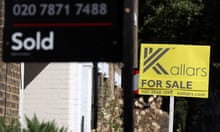The number of buy to let mortgages in arrears has doubled in a year while the number of homeowners falling behind on payments has also jumped, prompting warnings that the sharp rise “should be ringing alarm bells in Downing Street”.
Two sets of official data underlined how 14 consecutive interest rate increases, on top of broader cost of living pressures, have piled the pain on many households, with landlords, in particular, struggling.
For many amateur landlords, their property portfolio is their main “pension”, but Ranald Mitchell, a director at mortgage broker Charwin Private Clients, said: “What was once a dream has turned into a nightmare for many.” Justin Moy, the managing director of EHF Mortgages, said the situation was “becoming a disaster for all types of landlord”.
The banking trade body UK Finance said there were 11,540 buy to let mortgages in arrears in the period 1 July to 30 September this year – up 29% on the previous quarter, and up 100% on the 5,760 that were in the red during the same period last year.
Meanwhile, 87,930 homeowner mortgages were in arrears during the three months ending on 30 September. This was 7% higher than the figure for the previous three months, and up 18% on an annual basis.
A succession of surveys have showed that hundreds of thousands of UK households have recently missed or defaulted on a mortgage or rent payment, with many forced to make big changes to their finances – from selling up and moving to a cheaper home to stopping pension contributions – as they struggle to cope with dramatically higher costs.
Britain’s amateur landlords have enjoyed years of strong house price growth, while intense competition among tenants has sent rents soaring. Now, like owner-occupiers and would-be buyers, many have seen their monthly mortgage costs double, or worse, since interest rates started their upwards march.
In many cases, their new mortgage payments are higher than the rent they are getting, while some struggling tenants have been unable to pay their rent and some have moved out, increasing landlords’ “void periods” when properties sit empty.
Craig Fish at the broker Lodestone Mortgages & Protection said the buy to let sector “has been hit harder than any of late”, adding: “Worse is yet to come … I predict a horrible ending.”
Separate figures on Thursday from the Ministry of Justice covering England and Wales showed that mortgage possession actions – where, for example, a bank is considering taking back a property from a customer who has fallen behind with their payments – have risen by up to 18% in a year.
Its figures compare July to September 2023 with the same period last year. However, home repossessions by county court bailiffs are down by 18% year on year – from 758 to 622.
Comparisons are tricky because there was a ban on home repossessions for a time during the pandemic. As a result, there were only 10 repossessions from April 2020 to March 2021.
Repossessions topped 9,000 in the first three months of 2009, in the aftermath of the financial crash.
The UK Finance data also showed a fall in the number of homeowner-mortgaged properties repossessed by lenders during the third quarter of this year. However, its data showed that 450 buy to let properties were repossessed between 1 July and 30 September compared with 400 during the same period last year – an increase of almost 13%.
Some mortgage commentators have said it is now much harder to repossess someone’s home. A “mortgage charter” struck between the government and Britain’s biggest lenders this year included a number of forbearance measures, including a pledge that no home would be repossessed within 12 months of the first missed payment.
Angela Rayner, Labour’s deputy leader and the shadow housing secretary, said of the Ministry of Justice data: “These figures lay bare the devastating impact of the Tories’ abject failure to tackle the housing crisis, with a toxic mix of rising rents and failure to end no-fault evictions hitting vulnerable people.”
Sarah Olney, the Liberal Democrat Treasury spokesperson, said: “This sharp rise in mortgage arrears should be ringing alarm bells in Downing Street … homeowners facing mortgage misery should be offered a rescue scheme, with targeted support to protect those most at risk of losing their home.”
The Department for Levelling Up, Housing and Communities said home repossession was always a last resort, and that the mortgage charter made it easier to manage monthly repayments. A spokesperson added: “Our landmark renters reform bill offers better protections for tenants and gives them greater security to challenge poor conditions in their homes.”










